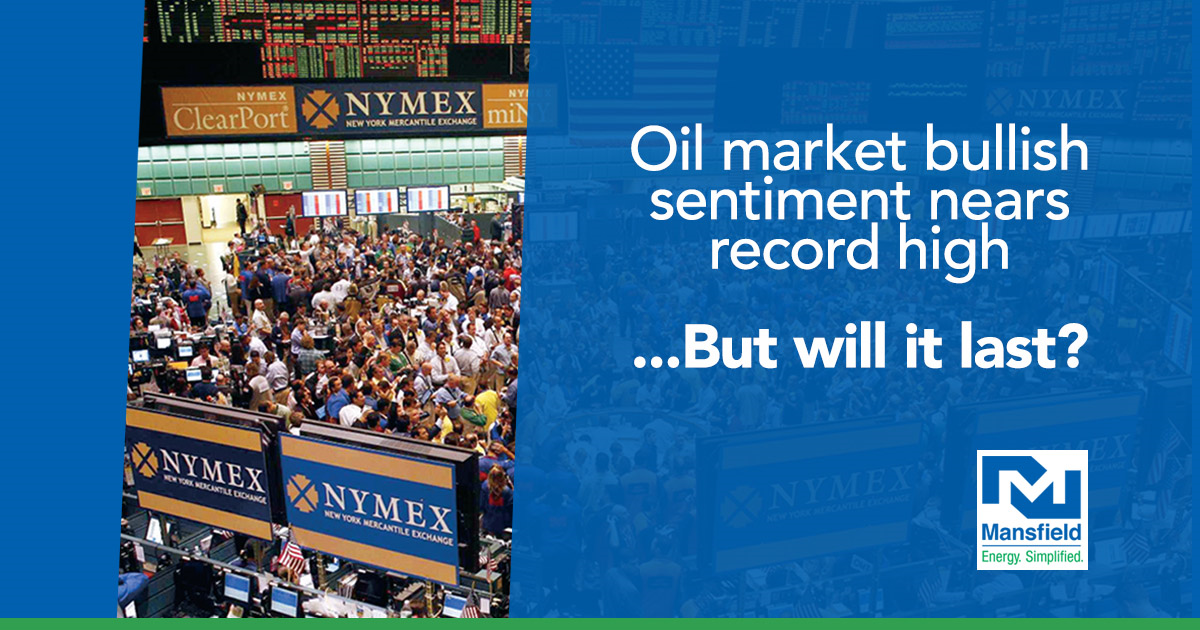
Oil Market Bullishness Nears Record Highs
Oil prices have been winding higher since September, when Harvey kicked off a strong rise in refinery run rates that buoyed crude demand. Since September, crude prices have risen from below $50 to consistently above $55 in November and December – far above the overall 2017 average price of $55.33 YTD. Behind that price movement has been a steady rise in bullish sentiment in the market. Last February, markets hit an all-time high, with NYMEX WTI Crude money net length reaching over 405 thousand contracts. Net length today is close to that level once again. Let’s break that down quickly.
CFTC Data Background
Each week, the CFTC (Commodity Futures Trading Commission, a government agency) releases trading data (called the Commitments of Traders Report, or COT) to provide transparency to U.S. commodity markets. The COT breaks down the position of numerous groups in the market – commercial traders, non-commercial money, and other reportables. For a background on commodity market futures trading, click here.
Commercial traders are groups that either produce or consume oil. For crude oil, this is predominantly made up of producers, shippers, and refineries. Commodity markets originated as a place for users and producers to buy and sell oil in the future, allowing for more predictable cash flow. Because these groups are directly involved in oil market trends, they often have a good eye for where prices will go.
Non-Commercial traders are large institutional groups that trade for speculative profit. This group is also called “managed money” or “smart money.” Non-Commercial traders are large hedge funds or other major institutional trading groups that are speculating on whether prices will rise or fall. These groups often have large budgets for research and analysis, so this group is closely monitored by markets to determine market sentiment.
Other Reportables are small traders who are not required to individually report a position in the market. Because this group is small and often less experienced than the institutional groups, this pool tends to be the least predictive of future price actions.
If you’ve ever researched financial markets, long/short are terms you’ll recognize. To be long in the market means you’ve purchased contracts and expect the market to rise, giving you a profit in the future. Shorting the market means you’ve sold promises of contracts that you’ll deliver later on. Short traders hope markets fall, so they can buy back contracts at a lower price than they sold them. To determine the sentiment of markets, net length is evaluated – the total number of long contracts minus short contracts. For oil, it’s helpful to remember that one contract is 1,000 barrels (42,000 gallons).
Where’s the Smart Money Going?
Non-Commercial Managed Money is typically used as the best indicator of market sentiment, since those groups are playing the market to make a profit, rather than simply locking in cash flow or expenses. In February, the net length hit an all-time high over 400,000 contracts (half a billion barrels of crude). OPEC’s recently implemented production cuts were taking hold of markets, and institutional investors responded by betting on rising oil prices. Since February, prices have fallen, hitting a low over the summer around 100,000 contracts.
Last Friday’s CFTC report showed that we’re back near record bullishness. For money managed NYMEX crude oil, net length is now just shy of 400,000 contracts. Markets are reacting to improving fundamentals in the market – demand is expected to be strong over the coming year, and OPEC’s strict adherence to their cuts has helped rebalance markets, pushing markets higher. Going into the OPEC meeting last week, markets were confident that the cuts would be extended and prices would continue to be supported.
In the below chart, the green line represents crude oil, while the blue bars show historical CFTC data. Declining prices are accompanied by lower net length, while higher net length comes with higher prices. The notable exception to this trend was in February 2017, when net length hit a record high despite flat crude oil prices. Markets bet heavily on OPEC moving the market higher, but OPEC was unable to deliver, leading to a large sell-off.
The Downside of Record-Level Sentiment
While high net length shows a strong expectation of rising prices, the real-world reaction could pull the other way. With investors placing record numbers of bets on oil prices, few plan on upping their ante. While crude market fundamentals are driven by supply and demand of physical oil, financial contracts are driven by the supply and demand of traders.
Without new demand from traders, it will be hard to continue pushing prices higher. OPEC helped keep markets engaged, but from here the next major planned event will be OPEC’s follow-up meeting in June. Absent a surprise to prop up the market (a demand revision higher, production disruptions, geopolitical instability, etc), traders have little support to stay in the market. Many will take their profits and sell their position, adding to the supply of the market.
Mean reversion is a major factor. Record highs are significant for a reason. They typically don’t last long, and the reversion to lower levels will come with lower prices. It’s possible for prices to rise from here, but it will take a major surprise factor to keep the momentum going.
This article is part of Daily Market News & Insights
Tagged: CFTC, Commitment of Traders, Smart Money, Speculation
MARKET CONDITION REPORT - DISCLAIMER
The information contained herein is derived from sources believed to be reliable; however, this information is not guaranteed as to its accuracy or completeness. Furthermore, no responsibility is assumed for use of this material and no express or implied warranties or guarantees are made. This material and any view or comment expressed herein are provided for informational purposes only and should not be construed in any way as an inducement or recommendation to buy or sell products, commodity futures or options contracts.







